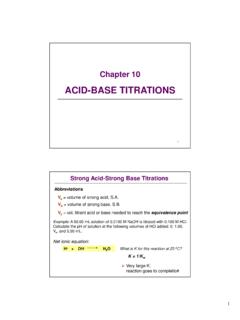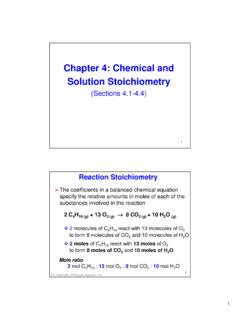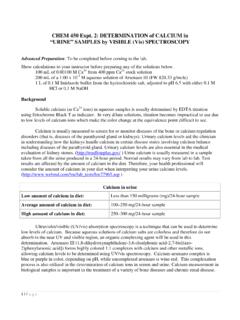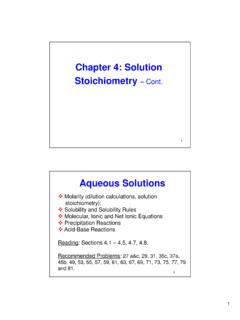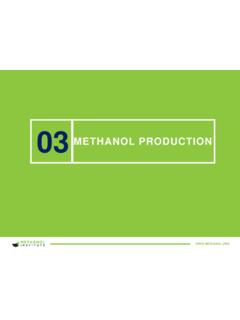Transcription of WASTE MINIMIZATION, UTILIZATION, and …
1 1 Lecture Topic #2 (Chapter 20) WASTE minimization , utilization , and TREATMENT1 MAJOR TOPICS Means for minimizingwaste Utilizingmaterials that might go into WASTE Treatingwaste Disposingwaste 22 Federal requirements: In 1984, amendments to the Resource Conservation and Recovery Act (RCRA) established the following national policy, making WASTE minimization the Nation's preferred hazardous WASTE management practice:"..the generation of hazardous WASTE is to be reducedor eliminatedas expeditiously as possible.
2 WASTE that is nevertheless generated should be treated, stored, or disposed ofso as to minimize the present and future threat to human health and the environment. (RCRA [b], 1984) Policies and Guidance Related to WASTE Minimization3In 1990, passage of the Pollution Prevention Actexpanded the Nation's WASTE prevention policy beyond a "RCRA-only" framework, to minimizing or eliminating toxic releases to all environmental media and natural resources:Policies and Guidance, Cont."The Congress hereby declares it to be the national policy of the United States that pollution should be prevented or reduced at the sourcewhenever feasible; pollution that cannot be prevented should be recycledin an environmentally safe manner, whenever feasible; pollution that cannot be prevented or recycled should be treatedin an environmentally safe mannerwhenever feasible.
3 And disposal or other releaseinto the environment should be employed only as a last resortand should be conducted in an environmentally safe manner." (PPA, Section 6602[b])43 HAZARDOUS WASTE MANAGEMENTG oals: Prevent generation of WASTE If WASTE is unavoidable, reduce amount of WASTE producedWASTE Recycle it If not recyclable, treat it to become non-hazardous If it cannot be made non-hazardous, dispose of it in a safe manner Once disposed, monitor for leaching and other adverse effects5 WASTE treatment Management OptionsMost effectiveLeast effective64 Source Reduction.
4 Any practice which reduces the amount of any hazardous substance, pollutant or contaminant from entering any WASTE stream or otherwise be released to the environment prior to recycling, treatment or disposal. Recycling: The use, reuse, or reclamation of WASTE . WASTE minimization : Includes source reduction and environmentally sound recycling. It is preferable when possible to conduct recycling at on-site locations. Some recycling activities require a 's WASTE minimization Program Complete eliminationof, or substitution for, priority chemicals, wherever possible;2.
5 Minimizingthe amount of priority chemicals used whenever elimination or substitution is not possible;3. Maximizing recyclingwhenever elimination, substitution, or minimization is not possible, creating closed loop materials management systems that eliminate or constrict release pathways;4. Promoting cradle-to-cradle WASTE managementinstead of cradle-to-grave WASTE management;5. Increase cooperative efforts between EPA, States, and the regulated community through 's WASTE minimization Program GoalsWhat are priority chemicals?
6 31 chemicals found in our nation's products and wastes For a complete list go to 28 organics halogenated, PCBs and PAHs 3 metals Cd, Hg and Pb Persistent, bioaccumulative, and toxic (PBT) Industrial WASTE Found in the environment and plant, animal, and human tissue due to past and present releases. 9 SOURCE REDUCTIONTo reduce or eliminate the amount and/or toxicity of WASTE at the sourcebefore recycling, treatment , or : Examples: Modification of equipment or technology Redesign of products Substitution of less toxic raw materials Improvement in work practicesChange in chemistryinvolvedEngineeringchangeManage ment change106 WASTE RECYCLING and REUSEP erform on-site whenever possible Avoids moving WASTE Processes that produce recyclable WASTE are likely to have use for them Examples of recycling Ferrous metals Other metals, such as Al, Cu & Zn Glass Paper Plastic 11 RECYCLING PROCESS.
7 ExampleRecovery and reuse of hazardous halogenated solvents127If WASTE cannot be recycled, what can be done to prevent potential threat to humans and the environment?13 treatment of WASTET hree Major Levels InvolvedPrimary treatment Physical processes that prepare WASTE for further treatment Physical/chemical processes that destroy and remove hazard Such as treatment of waterthat is removed from wasteSecondary treatmentPolishing Also treatment of other productsGoal is to discard safely after treatment148 treatment of WASTE (Cont.)
8 Chemical of WASTE (Cont.)Some Physical treatment MethodsMolecular separation Where dissolved contaminants or solvent pass through a size-selective membraneunder pressureMolecular Separation MethodAllows passage of:HyperfiltrationSpecies with MW 100-500 Utrafiltration Organic solutes with MW 500-1,000,000 Reverse osmosisWater only (Excludes ionic species)169 treatment of WASTE (Cont.)Chemical treatment Methods Applicability depends on chemical properties of WASTE components Includes one or more of the following methods:Recovery of metals Cd, Cu, Au, Ag, Pb and Zn by direct deposition of ions into the cathode as reduced metal +(aq) => Ag(s)ElectrolysisOxidation of organic matter (OM) into CO2gas and water; Oxidation or reduction of inorganic speciesOxidation-ReductionRemoval of toxic metal ions by precipitation as metal hydroxide or sulfide.
9 Ex. Cd2+=> CdS (s) ;Cr3+=> Cr(OH)3 (s) Chemical precipitationUse of lime [Ca(OH)2] to treat acidic WASTE ; Use of acetic acid to treat alkaline wasteAcid/Base neutralizationExample or ApplicationChemical MethodRemoval of low levels of ions onto a solid resinCation exchange resin removes (+) ions; Anion exchange resin removes (-) ionsIon exchange17 treatment of WASTE (Cont.)Thermal treatment Methods Most widely used thermal treatment method is incinerationIncineration of WASTE Utilizes the following conditions that destroy WASTE : High T Oxidizing atmosphere Turbulent combustion conditionsDefinition:Hazardous WASTE incineration Process that exposes hazardous WASTE to oxidizing conditions at high temperatures (>900 0C) 1810 Hazardous WASTE incineration(Cont.)
10 Application:1) Destruction of OM2) Destruction of halogenated compounds Ex. MeOH, Acetonitrile, Toluene, Xylene Ex. Nonflammable organochlorine WASTE Will not easily burn; Requires a supplemental fuellike methaneTREATMENT of WASTE (Cont.)19 treatment of WASTE (Cont.)Incinerator System2011 Systems(Cont.)Major components and function:1) WASTE preparation system Involves processes that prepare WASTE for combustionEx. Shredding of solids; Settling of liquid-solid WASTE to remove solids and waterTREATMENT of WASTE (Cont.


